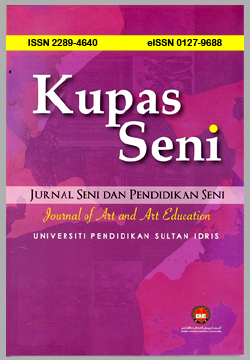Mughal Miniature Painting: An Analytical Study of the Akbar’s Ramayana
DOI:
https://doi.org/10.37134/kupasseni.vol11.2.6.2023Keywords:
Ramayana, Akbar, Mughal painting, Hinduism, Persian manuscripts, miniature paintingAbstract
While the influence of Emperor Akbar’s religious tolerance and patronage of the arts on the development of Mughal miniature painting is widely recognized, this research provides a detailed analysis of the artistic elements in Akbar’s Ramayana. Mughal patronage produced fine illustrated manuscripts, outstanding artistic achievements within a sophisticated cultural context. The translation of Hindu epic scriptures, the Mahabharata and the Ramayana, during Akbar’s reign gave rise to Mughal miniature painting an excellent, refined school which amalgamated Indian themes with the rich tradition of Persian miniature painting. This study primarily focuses on the artistic aspects of Akbar’s Ramayana and will provide a nuanced understanding of the blend of Persian and Indian art forms. A brief introduction about its translation to Persian and the social sensitivities provide a historical context leading up to this remarkable act. The central focus is on the pictorial elements, exploring the stylistic treatment of lines, colours, figures, natural elements, architectural features, composition, and layout. A short passage discusses ‘artists and the production process. Seven illustrations from Akbar’s Ramayana were selected to provide visual references to enhance discussions. This research aims to elucidate how Akbar’s Ramayana instigated a significant cultural shift in Indian society through unique aesthetics.
Downloads
References
Allami, Abul-Fazl-I. (1872). Ain-i- Akbari. (Vol I) [The Ain-i- Akbari] Blochmann, M.A. H (ed). Calcutta: Baptist Mission Press.
Bailey, Gauvin Alexander. (2021). The Truth-Showing Mirror: Jesuit Catechism and the Arts in Mughal India. In Frederiks, Martha & Nagy, Dorottya (Eds.), Critical Readings in the History of Christian Mission (p. 1452–1471). BRILL.
Beach, Milo Cleveland. (1987). Early Mughal Painting. Cambridge/ London: Harvard University Press.
Beach, Milo Cleveland. (1981). The Imperial Image: Paintings for the Mughal Court. Washington D.C: Freer Gallery of Art, Smithsonian Institution.
Brand, Michael and Lowry, Glenn D. (1986). Akbar’s India: Art from the Mughal City of Victory. New York: The Asia Society Galleries.
Brockington, John. Illustrated Ramayana Manuscripts. Retrieved from https://lib.kunstkamera.ru/files/lib/978-5-88431-366-8/2/04_brockington.pdf. June 5, 2022.
Chakraborty, S. S. (2022). Queer Labors: Female Intimacy, Homoeroticism, and Cross-dressing in Mughal Courtly Paintings. Visual Culture & Gender, 17, 33-50.
Daljeet, Dr. and P.C. Jain. (2006). Indian Miniature Painting, Manifestation of a Creative Mind. New Delhi: Brijbasi.
Das Ashok Kumar. (1994). Akbar’s Imperial Ramayana: A Mughal Persian Manuscript. The Legend of Rāma: Artistic Visions. Ed. V. Dehejia. Mumbai: Mar, 73-84.
Das, Ashok Kumar. (1983). Notes on the Emperor Akbar’s Manuscript of the Persian Ramayana, Asian Variations in Ramayana. Ed. K. R. S. Iyengar. New Delhi: Sahitya Akademi. 144-153.
Das Asok Kumar (2009). Salim’s Taswirkhan. Bombay: Modern Architecture Research Group.
Deodhar, Chinmayi H. (2021). Indra: His Stories through the Ages. Journal of the Ganganatha JHA Campus, 177-188.
Faruqi, Burhan Ahmad. (1940). Mujaddid’s Conception of Tawhid. Lahore: Seraj Munir, Institute of Islamic Culture.
Gandhi, Supriya. Adi Shakti. (2009). Retrieved from http://www.adishaktitheatrearts.com/Rāma yana-articles/88-q-persian-Rāma yana-q-by-dr-supriya-gandhi.html. 27 Nov 27, 2012.
Hajianfard, Ramin. (2017). Mughal Miniature Painting: An Analytical Study of The Translated-Illustrated Manuscripts of The Ramayana [Doctoral dissertation].
Hodgkin, Howard. (1997). Episodes Taken from the Epics. Indian Miniatures and Paintings from the 16th to the 19th Century. Ed. Filippi, Gian Giuseppe. Milan: Electa, 40-55.
Isar, Renee and Raj (1981). Akbar at Fatehpur Sikri. London: History Today, 44-48.
Koch, Ebba. (1987). Pietre Dure and other Artistic Contacts between the Court of the Mughals and that of the Medici. A Mirror of Princes: The Mughals and the Medici. Ed. Dalu Jones, Bombay: Marg Publications, 29-56.
Krüger, Klaus, M., & Koch, Ebba. (2019). Being Like Jesus and Mary: The Jesuits, the Polyglot Bible and Other Antwerp Print Works at the Mughal Court. In K. Kern, Margit (Ed.), Transcultural imaginations of the sacred (pp. 197-230). Fink Wilhelm GmbH + Co.KG.
Leach, Linda York &Khalili, Nasser. (1998). Paintings from India. London: Nour Foundation.
Pinder- Wilson, Ralph. (1985). Studies in Islamic Art. London: The Pindar Press.
Ray, Niharranjan. (1975). Mughal Court Painting. Calcutta: Indian Museum.
Rice, Yael. (2017). Workshop as Network: A Case Study from Mughal South Asia”. Artl@s Bulletin, 6(3), 50-65.
Rogers, J.M, Mughal Miniatures. (1993). London: The Trustees of the British Museum, 1993.
Seyller, John (1990). Codicological Aspects of the Victoria and Albert Museum Akbarnāma and Their Historical. Art Journal, Vol. 49. Issue. 4, 379-387.
Seyller, John. (2010). Mughal and Deccani Paintings. Zurich: Museum Rietberg Zurich.
Staff, Sun Feature Stories. (2010). The Mughal Influence on Vaisnavism, Part 18. Retrieved from http://www.harekrsna.com/sun/features/05-10/features1741.htm. November 10, 2022
Strong, Susan. (2002). Painting for the Mughal Emperor: The Art of the Book 1560-1660. London: V&A Publication.
Truschke, Audrey. (2012). “Cosmopolitan Encounters: Sanskrit and Persian at the Mughal Court.” Diss. Columbia University.
Vanina, Eugenia Yurevna. (1996). Ideas and Society in India from the Sixteenth to the Eighteenth Centuries. New Delhi: Oxford University Press, 1996.
Zekrgoo, Amir H. (2000). Islamic Art: Its Contribution to the Hindu Scriptures. Saye-e-Tooba: The essays published in conjunction with the 1st painting Biennial of the Islamic World Conference. Tehran: Museum of Contemporary Arts. 2000. Print.
Zekrgoo, Amir H. (2017). Symbolism in Oriental Arts. Vol.5: Gestures & Postures in Buddhist & Hindu Arts. Tehran: MATN Publishing, Iran Academy of Art. 56-60, 174-5.
Downloads
Published
Issue
Section
License
Copyright (c) 2023 Ramin Hajianfard, Amir H. Zekrgoo

This work is licensed under a Creative Commons Attribution-NonCommercial-ShareAlike 4.0 International License.





